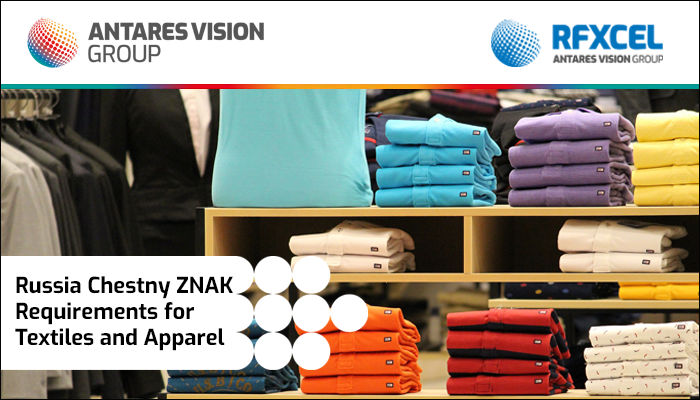There’s always something interesting going on with Chestny ZNAK, Russia’s National Track and Trace Digital System. (Well, we think it’s interesting, and chances are you do too if you’re reading this.). Adjustments, pilots beginning and ending, mandatory product labeling going into effect … it’s a treasure trove of track and trace. Such is the case with today’s topic: Russia’s textile and apparel supply chain.
Technically, Chestny ZNAK refers to some facets of the textile and apparel supply chain as “clothing items and light industry goods.” The category includes coats, shirts, blouses, and linens.
Globally, footwear and some items made with fur are certainly part of the textile and apparel supply chain. Chestny ZNAK, however, treats these as separate categories, so we’re not including them in today’s discussion. We’ve written about footwear before — mandatory serialization and other requirements went into effect on July 1, 2020 — and you can learn more about requirements for fur (and all regulated product categories) by downloading our “Overview of Chestny ZNAK Compliance for Key Industries” white paper. It’s fully updated for 2021 and available in both English and Russian.
Okay, let’s get into clothing items and light industry goods in Russia’s textile and apparel supply chain.
Serialization in Russia’s textile and apparel supply chain
A pilot for clothing/light industry products was conducted during the second half of 2019, and mandatory labeling began on January 1, 2021. To date, Chestny ZNAK reports that more than 130,000 textile and apparel supply chain stakeholders have been issued more than 1.4 billion marking codes.
All products must be labeled with a DataMatrix code containing four data points:
- A 14-digit Global Trade Item Number (GTIN)
- A 13-digit serial number
- A 4-digit verification key
- A 44-digit verification code (i.e., crypto code)
The Center for Research in Perspective Technologies (CRPT), which manages Chestny ZNAK, issues verification keys, crypto codes, and serial numbers. Manufacturers, importers, wholesalers, and retailers, referred to as “economic agents,” can also generate serial numbers.
Before economic agents are issued codes, they must create a “product card” for Russia’s catalogue of marked goods. These must note four product attributes
- The product name
- The 4-character EAEU Combined Nomenclature of Foreign Economic Activity (TN VED) code
- The corresponding GTIN
- The trademark (if any)
New goods produced in Russia must be marked before leaving the factory. For importation from other Eurasian Economic Union (EAEU) countries (Armenia, Belarus, Kazakhstan, and Kyrgyzstan), codes must be applied before the goods enter Russia’s textile and apparel supply chain. For imports from all other countries, codes must be applied before customs processes begin.
Economic agents must have an encrypted digital signature and equipment to handle codes, including scanners, printers, and point-of-sale cash registers connected to the internet (for retail sales).
These are the broad strokes of compliance for the textile and apparel supply chain. For full details, be sure to download our white paper.
Final thoughts
Russia’s textile and apparel supply chain is large and lucrative. But to participate and succeed, you need to be able to navigate Chestny ZNAK’s strict requirements. To do this, you need the right partner, one that knows the regulations, has a local team, and actually has active in-country implementations.
Right off the bat, we can say that we’re the only official CRPT software or integration partner for clothing items and light industry goods. In fact, we’re the only official CRPT partner for several other industries; we’ve proven that our signature rfxcel Traceability System integrates seamlessly with Chestny ZNAK and meets regulatory requirements for key industries. We were also recently accredited as an IT company by the Ministry of Digital Development, Communications, and Mass Media.
To learn more about our leadership in Russian supply chain compliance, check out these recent blog posts:
- Russia Chestny ZNAK Bottled Drinking Water Pilot Ending Soon
- New Russian Serialization Pilot for Biologically Active Food Additives
- Russia Serialization Pilot to Combat Counterfeit Beer Set to Begin This Spring
- What Does It Mean to Be a CRPT Partner in Russia’s Supply Chain?
If you have questions about the textile and apparel supply chain in Russia — or any other market where you’re doing business or want to do business — contact us today to schedule a demo. See how our powerful software can ensure you’ll remain compliant with textile and apparel supply chain regulations around the world.





